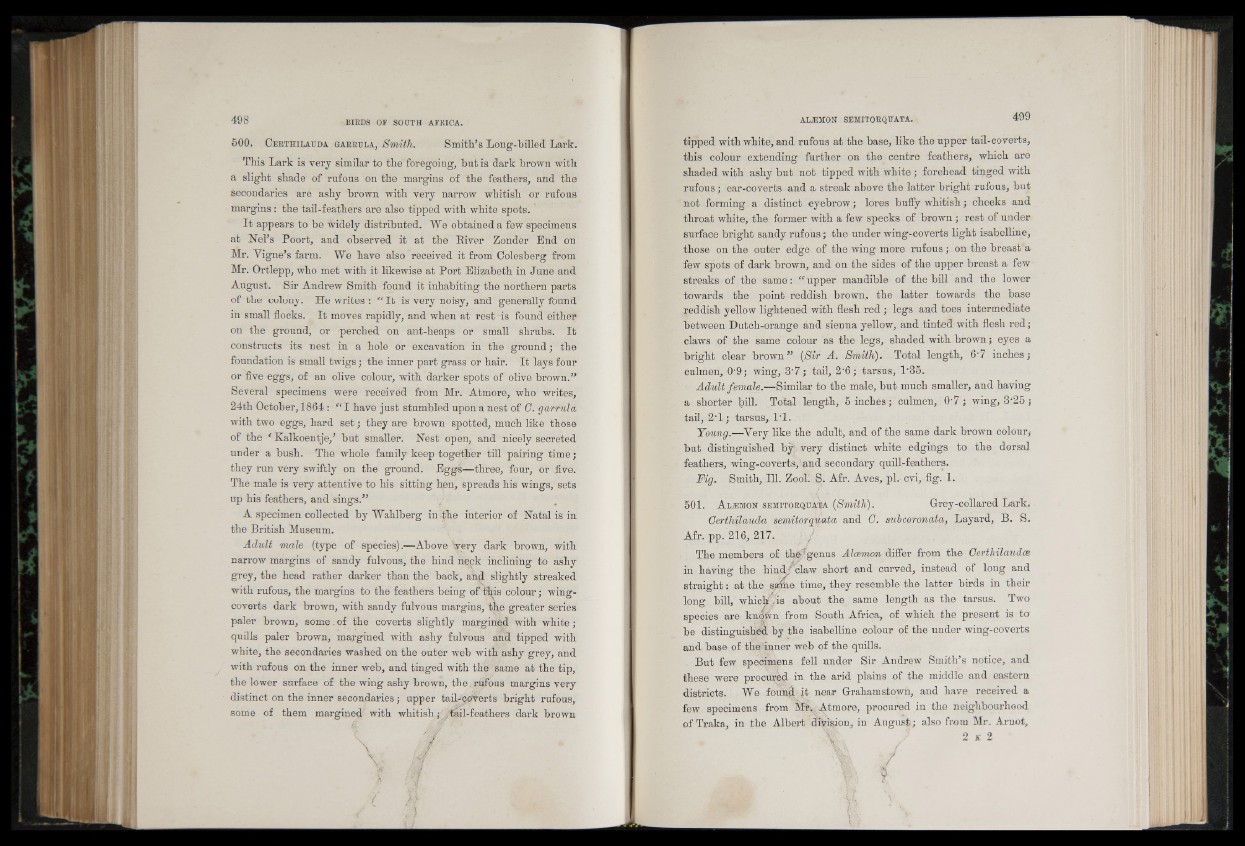
500. C erthilau d a garrula, Smith. Smith’s Long-billed Lark.
This Lark is very similar to the foregoing, bnt is dark brown with
a slight shade of rufous on the margins of the feathers, and the
secondaries are ashy brown with very narrow whitish or rufous
margins: the tail-feathers are also tipped with white spots.
I t appears to be widely distributed. We obtained a few specimens
at Nel’s Poort, and observed it at the River Zonder End on
Mr. Vigne’s farm. We have also received it from Colesberg from
Mr. Ortlepp, who met with it likewise at Port Elizabeth in June and
August. Sir Andrew Smith found it inhabiting the northern parts
of the colony. He writes : “ It is very noisy, and generally found
in small flocks. It moves rapidly, and when at rest is found either
on the ground, or perched on ant-heaps or small shrubs. It
constructs its nest in a hole or excavation in the ground; the
foundation is small twigs; the inner part grass or hair. It lays four
or five eggs, of an olive colour, with darker spots of olive brown.”
Several specimens were received from Mr. Atmore, who writes,
24th October, 1864 : “ I have just stumbled upon a nest of G. garrula
with two eggs, hard set; they are brown spotted, much like those
of the ‘ Kalkoentje,’ but smaller. Nest open, and nicely secreted
under a bush. The whole family keep together till pairing time;
they run very swiftly on the ground. Eggs—three, four, or .five.
The male is very attentive to his sitting hen, spreads his wings, sets
up his feathers, and sings.”
A specimen collected by Wahlberg in the interior of Natal is in
the British Museum.
Adult male {type of species).—Above Very dark brown, with
narrow margins of sandy fulvous, the hind neck inclining to ashy
grey, the head rather darker than the back, and slightly streaked
with rufous, the margins to the feathers being of this colour; wing-
coverts dark brown, with sandy fulvous margins, the greater series
paler brown, some. of the coverts slightly margined with white;
quills paler brown, margined with ashy fulvous and tipped with
white, the secondaries washed on the outer web with ashy grey, and
with rufous on the inner web, and tinged with the same at the tip,
the lower surface of the wing ashy brown, the,rufous margins very
distinct on the inner secondaries; upper tail-coverts bright rufous,
some of them margined with whitish;)/tail-feathers dark brown
tipped with white, and rufous at the base, like the upper tail-coverts,
this colour extending further on the centre feathers, which are
shaded with ashy but not tipped with white; forehead tinged with
rufous; ear-coverts and a streak above the latter bright rufous, but
not forming a distinct eyebrow; lores buffy whitish; cheeks and
throat white, the former with a few specks of brown ; rest of under
surface bright sandy rufous; the under wing-eoverts light isabelline,
those on the outer edge of the wing more rufous; on the breast a
few spots of dark brown, and on the sides of the upper breast a few
streaks of the same: “ upper mandible of the bill and the lower
towards the point reddish brown, the latter towards the base
reddish yellow lightened with flesh red ; legs and toes intermediate
between Dutch-orange and sienna yellow, and tinted with flesh red;
claws of the same colour as the legs, shaded with brown ; eyes a
bright clear brown” (Sir A. Smith). Total length, 6‘7 inches;
culmen, 0‘9; wing, 8'7; tail, 2‘6 ; tarsus, 1‘35.
Adult female.—Similar to the male, but much smaller, and having
a shorter {»ill. Total length, 5 inches; culmen, 0-7 ; wing, 3-25;
tail, 2T; tarsus, IT.
Young.—Very like the adult, and of the same dark brown colour,-
but distinguished by) very distinct white edgings to the dorsal
feathers, wing-coverts,' and secondary quill-feathers.
Fig. Smith, 111. ZooL S. Afr. Aves, pi. cvi, fig. 1.
501. A m m o n semitorquatja (Smith). Grey-collared Lark.
C&rthilauda semitorquata and G. subcoronata, Layard, B. S.
Afr. pp. 216, 217.
The members of the/genus Alcemon differ from the Gerthilaudce
in having the hind/claw short and curved, instead of long and
straight: at the sfme time, they resemble the latter birds in their
long bill, whief/, is about the same length as the tarsus. Two
species are knotra from South Africa, of which the present is to‘
be distinguished by the isabelline colour of the under wing-coverts
and base of the inner web of the quills.
But few specimens fell under Sir Andrew Smith’s notice, and
these were procured in the arid plains of the middle and eastern
districts. We found jt near Grahamstown, and have received a
few specimens from ML Atmore, procured in the neighbourhood
of Traka, in the Albert division, in August; also from Mr. Arnot,